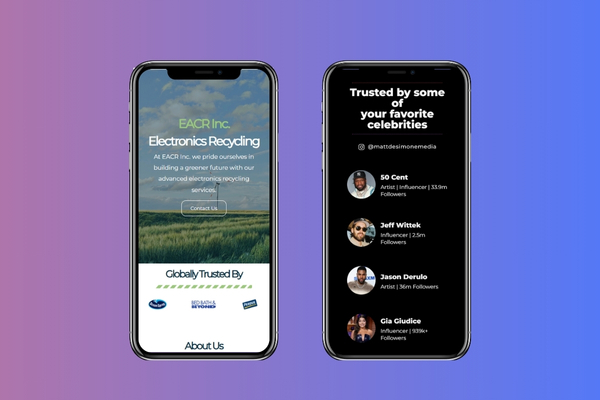In today’s digital landscape, the importance of mobile friendly website design can’t be overstated—especially when mobile devices now dominate how people browse, shop, and search. If your website doesn’t work well on a phone, you’re not just behind the curve—you’re losing traffic, leads, and credibility.
This blog will walk you through why having a mobile-friendly website is no longer a bonus—it’s essential. From usage stats to SEO implications, we’re breaking it all down.
Table of Contents
ToggleMobile Usage Trends You Can’t Ignore
Mobile traffic is the new normal
Over 60% of global web traffic now comes from mobile devices—and that number keeps growing. If your site isn’t built with mobile users in mind, you’re ignoring the majority of your visitors.
How people browse and buy
Think about it: people research restaurants, buy products, and book services from their phones—often in real-time. A clunky, slow, or unresponsive site won’t just frustrate users; it’ll send them straight to a competitor.
Modern users expect a flawless mobile experience
Today’s consumers are impatient. They expect websites to load fast, look good, and function smoothly on any screen size. If your mobile experience is anything less than seamless, they’ll bounce before you get a chance to impress.
Why Mobile-Friendliness Directly Impacts SEO
Google ranks mobile-first
Since 2019, Google has used mobile-first indexing. That means it primarily evaluates the mobile version of your website when determining search rankings. If your mobile site is outdated or non-functional, your visibility in search will suffer.
Slow = lost traffic
Mobile users won’t wait around for a slow-loading site. And neither will Google. High bounce rates and poor performance on mobile can tank your rankings, making it harder for anyone to find you.
Mobile usability is a ranking factor
Google doesn’t just check if your site works—it checks how well it works on mobile. Issues like small text, unclickable buttons, or horizontal scrolling can all negatively impact your SEO performance.
User Experience Is Everything
Easy to navigate, easy to stay
The importance of mobile friendly website design is clearest when you’re trying to navigate a site on your phone. If users have to pinch, zoom, or scroll sideways just to read or tap something, they’ll leave. Mobile-friendly design ensures content is readable, buttons are tap-friendly, and menus make sense—no matter the screen size.
Mobile design drives real engagement
A smooth mobile experience keeps users on your site longer and increases the chances they’ll take action. Whether it’s reading a blog, buying a product, or filling out a form, easy navigation leads to higher conversion rates.
A polished mobile site builds trust
A modern, well-designed mobile site tells visitors you’re legit. It gives the impression that your business is professional, current, and ready to serve. Poor mobile design, on the other hand? That’s a fast way to lose credibility.
Mobile-Friendliness Affects Sales & Leads
Consumers are buying from their phones
Today’s shoppers don’t wait until they’re home to make a purchase—they do it while commuting, at lunch, or in line at the store. If your checkout process or product pages aren’t optimized for mobile, you’re leaving money on the table.
Sales skyrocket with better mobile design
We’ve worked with clients who saw a 30%+ increase in conversions after optimizing their sites for mobile. Simply improving load times, streamlining navigation, and enhancing mobile visuals can drive dramatic results.
Lead forms and CTAs must be mobile-ready
You can’t expect users to fill out a clunky form on their phone. Your lead capture strategy should be designed for mobile from the start—with large input fields, minimal typing, and clear CTAs that are easy to click.
How to Tell If Your Website Is Mobile-Friendly
Use Google’s Mobile-Friendly Test
This free tool from Google gives you a simple pass/fail score and shows specific issues. Just enter your URL and get instant feedback: Google’s Mobile-Friendly Test
Visual red flags to watch for
Here are a few signs your site isn’t mobile-friendly:
- Text that’s too small to read without zooming
- Buttons or links placed too close together
- Horizontal scrolling or content spilling off the screen
Run a mobile audit for real performance insights
Tools like PageSpeed Insights, GTmetrix, or even a professional website audit can show you how your mobile site stacks up. And if you’re unsure where to start, our expert web design in NJ team can walk you through a full mobile performance review.
Mobile Optimization Is Not One-Size-Fits-All
Different industries, different needs
The importance of mobile friendly website design varies based on your audience. A restaurant website needs tap-to-call and easy menu browsing. An eCommerce brand must have lightning-fast product pages and a smooth checkout. A service-based business might prioritize quick load times and fast lead capture.
UX built for your business
Good mobile UX means knowing what your users need most—and delivering it fast. From location buttons to mobile-friendly galleries or instant chat, every feature should serve a purpose.
Responsive vs. adaptive: Know the difference
Responsive design adjusts fluidly to screen size. Adaptive design detects the device and loads a tailored layout. While responsive is more common, high-performing sites often blend both for maximum control.
Work With a Website Company in New Jersey That Prioritizes Performance
Results-driven, mobile-first
The importance of mobile friendly website development isn’t just about good looks—it’s about results. We’ve helped businesses across NJ improve conversions, reduce bounce rates, and boost rankings by going mobile-first in every project.
If you’re ready to improve your digital presence, work with a website company in New Jersey that prioritizes mobile performance from day one.
Let’s build something better together.
Conclusion: Mobile-Friendliness Is a Must for Long-Term Growth
If there’s one takeaway here, it’s this: the importance of mobile friendly website design is no longer optional—it’s foundational to your online success.
Mobile usage is growing, Google is watching, and your customers are expecting a seamless experience.
Not sure where your website stands? Run a quick test, or reach out for a free mobile performance check. We’ll help you identify what’s working—and what’s not—so you can stay competitive, no matter the screen size.


